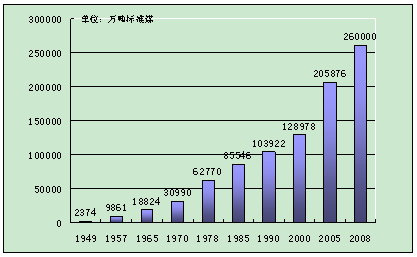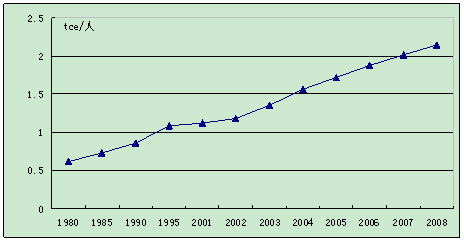Remarkable Achievements in 60 Years: Underpinnings of Rapid Economic Growth
China has made significant achievements in energy development since its birth 60 years ago. The energy supply is primarily based on coal and centered on electricity, with comprehensive development in oil, gas and renewable energy sources. The overall self-supply rate of energy always stays above 90%. In 2008, the primary energy output of China reached 2.6 billion tons of coal equivalent, 109.5 times that of 1949 and 4.2 times that of 1978. Energy development provides a solid basis for growth of the national economy and improvement in people's standard of life.
 |
|
Primary Energy Output of China Achieves an Over-100-fold Growth in its 60 Years' History (Unit: 10,000t coal equivalent) |
 |
I. Clean, efficient and convenient energy are increasingly available to improve the quality of life.
In early years of the new China Electricity is unavailable in almost all rural areas, where firewood and coal are the primary source of energy. Chinese people consumed less than 1 kW.h power per capita in 1949. Before the reform and opening up, coal accounted for over 90% of commercial energy for domestic use.
Since China started reform and opening up, energy for domestic use has experienced tremendous changes in quality and quantity. A great shift has been made from the focus on conventional biomass energy and coal to diversified portfolio of electricity, LPG, natural gas, coal and advanced biomass energy. High-quality energy has taken up a much higher proportion in energy for domestic use.
 |
|
Changes in Primary Energy Consumption Per Capita (tec per capita) |
Electricity availability has been increased remarkably in rural and remote areas through rural power grid upgrading projects and the "Brightness Program". Since 1998, China has spent over RMB400 billion in rural power supply projects. In 2008, domestic power consumption exceeded 300 kW per capita in rural areas, and the number of households having no access to electricity dropped to about 2 million.
 |
|
Electricity Made Available at Each Village |
Improvements in energy infrastructures provide a good basis for raising people's quality of life. 132.9, 100.3, 94.7 and 93.6 color televisions, air conditioners, washing machines and refrigerators are owned respectively every 100 urban households in 2008, compared with 99.2, 49.1, 30.2 and 9.8 for every 100 rural households in the year.
With rising standard of life, general people started to own private cars. Statistics show civil automobiles owned in China increased from 50,900 units in 1949 to 509.961 million units by the end of 2008, including 35,013,900 private cars. Domestic oil consumption has evolved from the kerosene for lamp use to LPG for cooking as well as gasoline and diesel fuels for cars.
 0
0 






